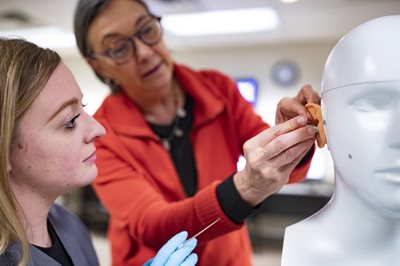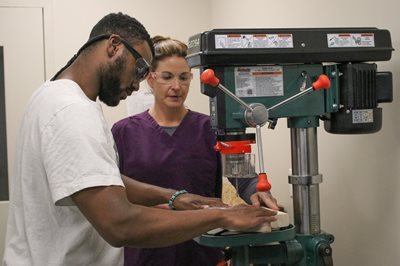Hear from Salus University faculty across academic programs as they bust common, program-specific healthcare myths.
 Myth #1: You have to be a pediatrician to specialize in kids’ healthcare.
Myth #1: You have to be a pediatrician to specialize in kids’ healthcare.
Bisant Labib, OD ‘14, FAAO: Optometry is in and of itself, like a primary care specialty. If you do decide that you want to specialize in the pediatric population, then you can do a residency just in the pediatric specialty, which we also offer here (at the Pennsylvania College of Optometry).
Julie Quinlan, MPO, MS, CPO, ATC, FAAOP: We don't want our students to go out into the field and be afraid to work with the pediatric population. They are so unique and so much fun, and a lot of our students have an interest in [working with] them.
Chad Duncan, PhD, CRC, CPO: We definitely work with pediatricians in that team aspect, but we're the ones that are individualizing the ankle-foot orthosis (AFOs) or the arms and legs for those kids. Pediatrics is absolutely a big piece of orthotics and prosthetics.
Brianna Brim, PhD '22, MOT, OTR/L, CPAM, CLIPP: There are so many occupational therapists (OTs) who work in pediatrics. It’s a specialty area of practice that a lot of OTs work with, and there are many who work fully with pediatric clients. That's a really beautiful thing especially in a field like occupational therapy, there's a lot of flexibility in what you’d like to do.
Aaron Roman, AuD, CCC-A, FAAA: If you think about pediatric healthcare in general, pediatrics or pediatricians are really the first step in getting you to where you need to go. A pediatrician is a specialist in generalized medicine around child healthcare, but from there, it depends on what you specialize in. You could be a pediatric audiologist or a pediatric speech-language pathologist. In my case, for example, I work sometimes in pediatrics and sometimes with adults so I kind of straddle both ends of the age spectrum.
Myth #2: You need eight years of schooling to work in healthcare.
Dr. Brim: There are a lot of different avenues to becoming a part of the medical field. Some avenues take about eight years for undergrad and doctoral programs. Even in OT, there are paths where you can take four years undergrad and two years for an OT. So the range is huge and there's a lot of other professions where it may even take you only five years to enter medicine.
Dr. Labib: You don't need eight years of school. Undergrad you can do in three years. I actually did my undergrad in less than four years. And, then we also have three plus four programs that are associated with other colleges and schools of optometry. (The Pennsylvania College of Optometry) also has an Accelerated Optometry Program. The first of its kind, not requiring an MD or PhD, where you can actually finish optometry school in three years.
 Myth #3: Audiologists only prevent and treat hearing loss.
Myth #3: Audiologists only prevent and treat hearing loss.
Dr. Roman: Audiologists treat hearing, that is absolutely one of the things we do. We also look at the hearing organ. We do testing and evaluation and treatment related to balance, as well as a lot of psychological and neurological phenomenons. Things like tinnitus, auditory processing, which is something that occurs at the level of the brain. Audiologists do all of that. We can look at anything within the hearing up to the brain and the balance system.
Myth #4: Healthcare is all science-based, with little opportunity to implement creativity.
Kimberly Cafarella, MS, CCC-SLP: I am a pediatric speech-language pathologist (SLP), and I would say there's a lot of room for working in creativity while you're also using evidence-based practice. For example, in my life outside of being an SLP, I'm involved with music and with community theater and I definitely find ways to bring that into my practice. I teach our graduate students how to use music as a way to facilitate language and how to incorporate evidence-based strategies for language facilitation with music.
Katherine Alstrin, EdD, TVI, COMS: In the Teacher of Students with Visual Impairment Program, it's actually not healthcare. However, we find it meshes really nicely with healthcare. We consider ourselves a hybrid profession where we bridge the medical and educational worlds together. It's a very cool job in that you get to live your best life, being very creative with your lessons, with just one student at a time. You can get to know them and do some very cool work with them. But then you also get to flex your science and your medical knowledge muscle. It's the best of two worlds coming together.
Myth #5: There is only one path into the Special Education field.
Dr. Alstrin: At Salus, we have what's called the Teacher of Students with Visual Impairments Program. This program prepares you to get your initial licensure into the special education field. A lot of people don't realize that they can come with a background in marketing or communication and do really well as a teacher of students with visual impairments. You work one-on-one with kids. You help educate the staff and work with families. It's a different and exciting area of special education.
 Myth #6: Clinical healthcare professionals do not build things - that’s only for engineers.
Myth #6: Clinical healthcare professionals do not build things - that’s only for engineers.
Quinlan: I am not surprised to hear that people don't know a whole lot about orthotics and prosthetics (O&P) because that is common. But if they knew more about it, they would know that it’s (building things) a main thing that we do in our profession.
Dr. Duncan: That's why I went into the [O&P] profession. I didn't want to be sitting behind the desk. I like to do things with my hands and build things. So we're like tinkerbells. We're problem solving and we're putting things together and making it custom to that person.It's just not off the shelf. We see them and we make something and then we get to fit them (the patients).
Quinlan: I had a patient who needed her AFOs, which are like braces, to go to the bathroom at night, and it was difficult for her. So I painted it to be glow in the dark so she could see them to get them on and go to the bathroom. To solve that problem, I had to be creative and think outside the box. I think it's such a combination of healthcare and some engineering, and to put those aspects together to create something for an individual to help them.
 Myth #7: Speech-language pathology only helps kids speak well.
Myth #7: Speech-language pathology only helps kids speak well.
Kelly Salmon, SLPD, CCC-SLP, BCS-S, CLT-LANA, NDC: Our profession is quite broad. Working with children is a big part of our profession, but we also serve the adult population as well, so, pediatrics, adolescents, adults, older adults, and all the way through the end of life. We also work on language and communication. We work on cognition, things like attention, memory, problem-solving, planning, and all of those higher-level thinking skills. We also have the opportunity to work in areas of voice and swallowing. There's quite a bit that we can do as speech-language pathologists outside of working just on speech.
Anne Ruckdeschel, MA, CCC-SLP, CBIS: As a speech therapist, I don't work with kids. I work with adults. What's so great about our job is that there's so many different aspects of the position and the field that you can get into. You can work with adults, you can work with kids, and you can work with anybody in between. Speech is one aspect of what we do. We cover everything from the neck up. Cognition is a big part of what we do with adults and if they've had a brain injury or stroke, attention, memory, all of those things. So we definitely work with kids who have speech and sound disorders, but we do so much more.